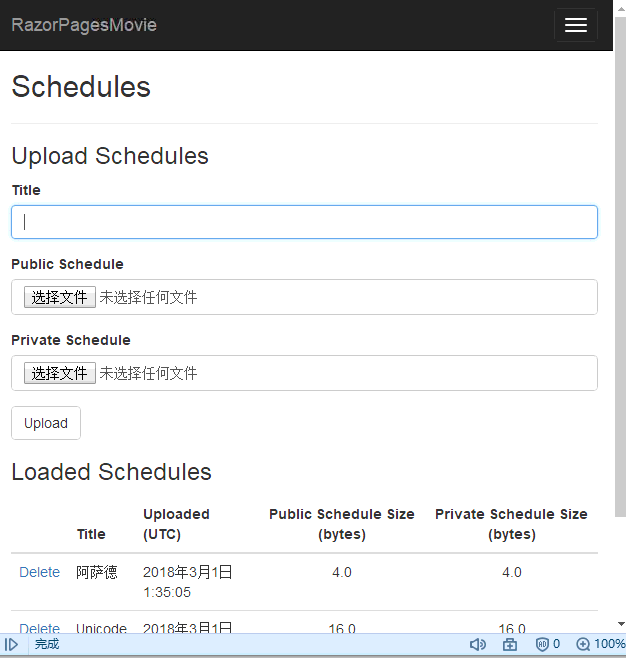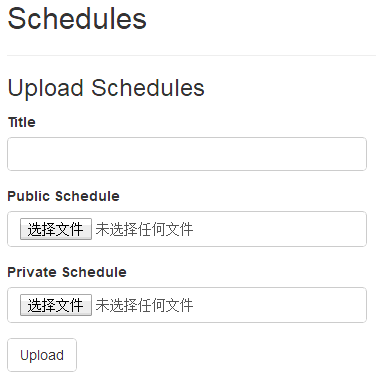本部分演示使用 Razor 页面上传文件。
本教程中的 Razor 页面 Movie 示例应用使用简单的模型绑定上传文件,非常适合上传小型文件。 有关流式传输大文件的信息,请参阅通过流式传输上传大文件。
在下列步骤中,向示例应用添加电影计划文件上传功能。 每个电影计划由一个 Schedule 类表示。 该类包括两个版本的计划。 其中一个版本 (PublicSchedule) 提供给客户。 另一个版本 (PrivateSchedule) 用于公司员工。 每个版本作为单独的文件进行上传。 本教程演示如何通过单个 POST 将两个文件上传至服务器。
添加 FileUpload 类
创建 Razor 页以处理一对文件上传。 添加 FileUpload 类(此类与页面绑定以获取计划数据)。 右键单击“Models”文件夹。 选择“添加” > “类”。 将类命名为“FileUpload”,并添加以下属性:
using Microsoft.AspNetCore.Http; using System.ComponentModel.DataAnnotations; namespace RazorPagesMovie.Models { public class FileUpload { [Required] [Display(Name="Title")] [StringLength(60, MinimumLength = 3)] public string Title { get; set; } [Required] [Display(Name="Public Schedule")] public IFormFile UploadPublicSchedule { get; set; } [Required] [Display(Name="Private Schedule")] public IFormFile UploadPrivateSchedule { get; set; } } }
此类有一个属性对应计划标题,另各有一个属性对应计划的两个版本。 3 个属性皆为必需属性,标题长度必须为 3-60 个字符。
添加用于上传文件的 helper 方法
为避免处理未上传计划文件时出现代码重复,请首先上传一个静态 helper 方法。 在此应用中创建一个“Utilities”文件夹,然后在“FileHelpers.cs”文件中添加以下内容。 helper 方法 ProcessFormFile 接受 IFormFile 和 ModelStateDictionary,并返回包含文件大小和内容的字符串。 检查内容类型和长度。 如果文件未通过验证检查,将向 ModelState 添加一个错误。
using System; using System.ComponentModel.DataAnnotations; using System.IO; using System.Net; using System.Reflection; using System.Text; using System.Threading.Tasks; using Microsoft.AspNetCore.Http; using Microsoft.AspNetCore.Mvc.ModelBinding; using RazorPagesMovie.Models; namespace RazorPagesMovie.Utilities { public class FileHelpers { public static async Task<string> ProcessFormFile(IFormFile formFile, ModelStateDictionary modelState) { var fieldDisplayName = string.Empty; // Use reflection to obtain the display name for the model // property associated with this IFormFile. If a display // name isn't found, error messages simply won't show // a display name. MemberInfo property = typeof(FileUpload).GetProperty(formFile.Name.Substring(formFile.Name.IndexOf(".") + 1)); if (property != null) { var displayAttribute = property.GetCustomAttribute(typeof(DisplayAttribute)) as DisplayAttribute; if (displayAttribute != null) { fieldDisplayName = $"{displayAttribute.Name} "; } } // Use Path.GetFileName to obtain the file name, which will // strip any path information passed as part of the // FileName property. HtmlEncode the result in case it must // be returned in an error message. var fileName = WebUtility.HtmlEncode(Path.GetFileName(formFile.FileName)); if (formFile.ContentType.ToLower() != "text/plain") { modelState.AddModelError(formFile.Name, $"The {fieldDisplayName}file ({fileName}) must be a text file."); } // Check the file length and don't bother attempting to // read it if the file contains no content. This check // doesn't catch files that only have a BOM as their // content, so a content length check is made later after // reading the file's content to catch a file that only // contains a BOM. if (formFile.Length == 0) { modelState.AddModelError(formFile.Name, $"The {fieldDisplayName}file ({fileName}) is empty."); } else if (formFile.Length > 1048576) { modelState.AddModelError(formFile.Name, $"The {fieldDisplayName}file ({fileName}) exceeds 1 MB."); } else { try { string fileContents; // The StreamReader is created to read files that are UTF-8 encoded. // If uploads require some other encoding, provide the encoding in the // using statement. To change to 32-bit encoding, change // new UTF8Encoding(...) to new UTF32Encoding(). using ( var reader = new StreamReader( formFile.OpenReadStream(), new UTF8Encoding(encoderShouldEmitUTF8Identifier: false, throwOnInvalidBytes: true), detectEncodingFromByteOrderMarks: true)) { fileContents = await reader.ReadToEndAsync(); // Check the content length in case the file's only // content was a BOM and the content is actually // empty after removing the BOM. if (fileContents.Length > 0) { return fileContents; } else { modelState.AddModelError(formFile.Name, $"The {fieldDisplayName}file ({fileName}) is empty."); } } } catch (Exception ex) { modelState.AddModelError(formFile.Name, $"The {fieldDisplayName}file ({fileName}) upload failed. " + $"Please contact the Help Desk for support. Error: {ex.Message}"); // Log the exception } } return string.Empty; } } }
以上内容如果看不懂就不用看了,核心思想就是检查上传文件是否合乎要求。
将文件保存到磁盘(拓展内容,本案例未用到)
示例应用将文件内容保存到数据库字段。 若要将文件内容保存到磁盘,请使用文件流:
using (var fileStream = new FileStream(filePath, FileMode.Create)) { await formFile.CopyToAsync(fileStream); }
将文件保存到 Azure Blob 存储(拓展内容,本案例未用到)
若要将文件内容上传到 Azure Blob 存储,请参阅使用 .NET 的 Azure Blob 存储入门。 本主题演示如何使用UploadFromStream 将文件流保存到 blob 存储。
添加 Schedule 类
右键单击“Models”文件夹。 选择“添加” > “类”。 将类命名为“Schedule”,并添加以下属性:
using System; using System.Collections.Generic; using System.ComponentModel.DataAnnotations; using System.ComponentModel.DataAnnotations.Schema; namespace RazorPagesMovie.Models { public class Schedule { public int ID { get; set; } public string Title { get; set; } public string PublicSchedule { get; set; } [Display(Name = "Public Schedule Size (bytes)")] [DisplayFormat(DataFormatString = "{0:N1}")] public long PublicScheduleSize { get; set; } public string PrivateSchedule { get; set; } [Display(Name = "Private Schedule Size (bytes)")] [DisplayFormat(DataFormatString = "{0:N1}")] public long PrivateScheduleSize { get; set; } [Display(Name = "Uploaded (UTC)")] [DisplayFormat(DataFormatString = "{0:F}")] public DateTime UploadDT { get; set; } } }
此类使用 Display 和 DisplayFormat 特性,呈现计划数据时,这些特性会生成友好型的标题和格式。
更新 MovieContext
在 MovieContext (Models/MovieContext.cs) 中为计划指定 DbSet:
using Microsoft.EntityFrameworkCore; namespace RazorPagesMovie.Models { public class MovieContext:DbContext { public MovieContext(DbContextOptionsoptions) : base(options) { } public DbSet Movie { get; set; } public DbSet Class { get; set; } public DbSet Schedule { get; set ; } } }
将 Schedule 表添加到数据库
打开包管理器控制台 (PMC):“工具” > “NuGet 包管理器” > “包管理器控制台”。
在 PMC 中执行以下命令。 这些命令将向数据库添加 Schedule 表:
Add-Migration AddScheduleTable
Update-Database
添加文件上传 Razor 页面
在“Pages”文件夹中创建“Schedules”文件夹。 在“Schedules”文件夹中,创建名为“Index.cshtml”的页面,用于上传具有如下内容的计划:
@page @model RazorPagesMovie.Pages.Schedule.IndexModel @{ ViewData["Title"] = "Schedules"; }Schedules
Upload Schedules
class="row">class="col-md-4">Loaded Schedules
| @Html.DisplayNameFor(model => model.Schedule[0].Title) | @Html.DisplayNameFor(model => model.Schedule[0].UploadDT) | class="text-center"> @Html.DisplayNameFor(model => model.Schedule[0].PublicScheduleSize) | class="text-center"> @Html.DisplayNameFor(model => model.Schedule[0].PrivateScheduleSize) | |
|---|---|---|---|---|
| "./Delete" asp-route-id="@item.ID">Delete | @Html.DisplayFor(modelItem => item.Title) | @Html.DisplayFor(modelItem => item.UploadDT) | class="text-center"> @Html.DisplayFor(modelItem => item.PublicScheduleSize) | class="text-center"> @Html.DisplayFor(modelItem => item.PrivateScheduleSize) |
每个窗体组包含一个
每个窗体组包含一个验证 。 如果用户输入未能满足 FileUpload 类中设置的属性特性,或者任何 ProcessFormFile方法文件检查失败,则模型验证会失败。 模型验证失败时,会向用户呈现有用的验证消息。 例如,Title 属性带有 [Required] 和 [StringLength(60, MinimumLength = 3)] 注释。 用户若未提供标题,会接收到一条指示需要提供值的消息。如果用户输入的值少于 3 个字符或多于 60 个字符,则会接收到一条指示值长度不正确的消息。 如果提供不含内容的文件,则会显示一条指示文件为空的消息。
添加页面模型
将页面模型 (Index.cshtml.cs) 添加到“Schedules”文件夹中:
using System; using System.Collections.Generic; using System.Threading.Tasks; using Microsoft.AspNetCore.Mvc; using Microsoft.AspNetCore.Mvc.RazorPages; using Microsoft.EntityFrameworkCore; using RazorPagesMovie.Models; using RazorPagesMovie.Utilities; namespace RazorPagesMovie.Pages.Schedule { public class IndexModel : PageModel { private readonly RazorPagesMovie.Models.MovieContext _context; public IndexModel(RazorPagesMovie.Models.MovieContext context) { _context = context; } [BindProperty] public FileUpload FileUpload { get; set; } public IListSchedule { get; private set; } public async Task OnGetAsync() { Schedule = await _context.Schedule.AsNoTracking().ToListAsync(); } public async Task OnPostAsync() { // Perform an initial check to catch FileUpload class // attribute violations. if (!ModelState.IsValid) { Schedule = await _context.Schedule.AsNoTracking().ToListAsync(); return Page(); } var publicScheduleData = await FileHelpers.ProcessFormFile(FileUpload.UploadPublicSchedule, ModelState); var privateScheduleData = await FileHelpers.ProcessFormFile(FileUpload.UploadPrivateSchedule, ModelState); // Perform a second check to catch ProcessFormFile method // violations. if (!ModelState.IsValid) { Schedule = await _context.Schedule.AsNoTracking().ToListAsync(); return Page(); } var schedule = new Models.Schedule() { PublicSchedule = publicScheduleData, PublicScheduleSize = FileUpload.UploadPublicSchedule.Length, PrivateSchedule = privateScheduleData, PrivateScheduleSize = FileUpload.UploadPrivateSchedule.Length, Title = FileUpload.Title, UploadDT = DateTime.UtcNow }; _context.Schedule.Add(schedule); await _context.SaveChangesAsync(); return RedirectToPage("./Index"); } } }
页面模型(Index.cshtml.cs 中的 IndexModel)绑定 FileUpload 类:
[BindProperty] public FileUpload FileUpload { get; set; }
此模型还使用计划列表 (IList) 在页面上显示数据库中存储的计划:
public IListSchedule { get; private set; }
页面加载 OnGetAsync 时,会从数据库填充 Schedules,用于生成已加载计划的 HTML 表:
public async Task OnGetAsync() { Schedule = await _context.Schedule.AsNoTracking().ToListAsync(); }
将窗体发布到服务器时,会检查 ModelState。 如果无效,会重新生成 Schedule,且页面会呈现一个或多个验证消息,陈述页面验证失败的原因。 如果有效,FileUpload 属性将用于“OnPostAsync”中,以完成两个计划版本的文件上传,并创建一个用于存储数据的新 Schedule 对象。 然后会将此计划保存到数据库:
public async TaskOnPostAsync() { // Perform an initial check to catch FileUpload class // attribute violations. if (!ModelState.IsValid) { Schedule = await _context.Schedule.AsNoTracking().ToListAsync(); return Page(); } var publicScheduleData = await FileHelpers.ProcessFormFile(FileUpload.UploadPublicSchedule, ModelState); var privateScheduleData = await FileHelpers.ProcessFormFile(FileUpload.UploadPrivateSchedule, ModelState); // Perform a second check to catch ProcessFormFile method // violations. if (!ModelState.IsValid) { Schedule = await _context.Schedule.AsNoTracking().ToListAsync(); return Page(); } var schedule = new Models.Schedule() { PublicSchedule = publicScheduleData, PublicScheduleSize = FileUpload.UploadPublicSchedule.Length, PrivateSchedule = privateScheduleData, PrivateScheduleSize = FileUpload.UploadPrivateSchedule.Length, Title = FileUpload.Title, UploadDT = DateTime.UtcNow }; _context.Schedule.Add(schedule); await _context.SaveChangesAsync(); return RedirectToPage("./Index"); }
链接文件上传 Razor 页面
打开“_Layout.cshtml”,然后向导航栏添加一个链接以访问文件上传页面:
class="navbar-collapse collapse">class="nav navbar-nav">
- "/Index">Home
- "/About">About
- "/Contact">Contact
- "/Product">产品展示
- "/Movies/Index">RpMovie
- "
/Schedule/Index">文件上传
现在可以运行看一下效果了
这里只能上传文本文件,还要注意.txt文件必须为Unicode文件类型,否则文件中带有汉字的话,上传后会提示错误消息
Error: Unable to translate bytes [D7] at index 0 from specified code page to Unicode.
解决方法:FileHelpers.cs文件中修改读取字符编码的格式为
using ( var reader = new StreamReader( formFile.OpenReadStream(),
new UTF32Encoding(false, false),//使用此字符编码 //new UTF8Encoding(encoderShouldEmitUTF8Identifier: false, throwOnInvalidBytes: true),//原字符编码 detectEncodingFromByteOrderMarks: true))
修改后上传文件中包含中文字符就没问题了。
添加计划删除确认页面
用户单击删除计划时,为其提供取消此操作的机会。 向“Schedules”文件夹添加删除确认页面 (Delete.cshtml):
@page "{id:int}" @model RazorPagesMovie.Pages.Schedule.DeleteModel @{ ViewData["Title"] = "Delete Schedule"; }Delete Schedule
Are you sure you want to delete this?
Schedule
class="dl-horizontal">
- @Html.DisplayNameFor(model => model.Schedule.Title)
- @Html.DisplayFor(model => model.Schedule.Title)
- @Html.DisplayNameFor(model => model.Schedule.PublicScheduleSize)
- @Html.DisplayFor(model => model.Schedule.PublicScheduleSize)
- @Html.DisplayNameFor(model => model.Schedule.PrivateScheduleSize)
- @Html.DisplayFor(model => model.Schedule.PrivateScheduleSize)
- @Html.DisplayNameFor(model => model.Schedule.UploadDT)
- @Html.DisplayFor(model => model.Schedule.UploadDT)
页面模型 (Delete.cshtml.cs) 在请求的路由数据中加载由 id 标识的单个计划。 将“Delete.cshtml.cs”文件添加到“Schedules”文件夹:
using System; using System.Collections.Generic; using System.Linq; using System.Threading.Tasks; using Microsoft.AspNetCore.Mvc; using Microsoft.AspNetCore.Mvc.RazorPages; using Microsoft.EntityFrameworkCore; namespace RazorPagesMovie.Pages.Schedule { public class DeleteModel : PageModel { private readonly RazorPagesMovie.Models.MovieContext _context; public DeleteModel(RazorPagesMovie.Models.MovieContext context) { _context = context; } [BindProperty] public Models.Schedule Schedule { get; set; } public async TaskOnGetAsync(int? id) { if (id == null) { return NotFound(); } Schedule = await _context.Schedule.SingleOrDefaultAsync(m => m.ID == id); if (Schedule == null) { return NotFound(); } return Page(); } public async Task OnPostAsync(int? id) { if (id == null) { return NotFound(); } Schedule = await _context.Schedule.FindAsync(id); if (Schedule != null) { _context.Schedule.Remove(Schedule); await _context.SaveChangesAsync(); } return RedirectToPage("./Index"); } } }
OnPostAsync 方法按 id 处理计划删除:
public async TaskOnPostAsync(int? id) { if (id == null) { return NotFound(); } Schedule = await _context.Schedule.FindAsync(id); if (Schedule != null) { _context.Schedule.Remove(Schedule); await _context.SaveChangesAsync(); } return RedirectToPage("./Index"); }
成功删除计划后,RedirectToPage 将返回到计划的“Index.cshtml”页面。
有效的 Schedules Razor 页面
页面加载时,计划标题、公用计划和专用计划的标签和输入将呈现提交按钮:
在不填充任何字段的情况下选择“上传”按钮会违反此模型上的 [Required] 特性。 ModelState 无效。 会向用户显示验证错误消息:
上传一个或多个计划时,“已加载计划”部分会显示已加载计划:
用户可单击该表中的“删除”链接以访问删除确认视图,并在其中选择确认或取消删除操作。
ASP.NET CORE RAZOR 到此结束
源代码
密码:rtr7





